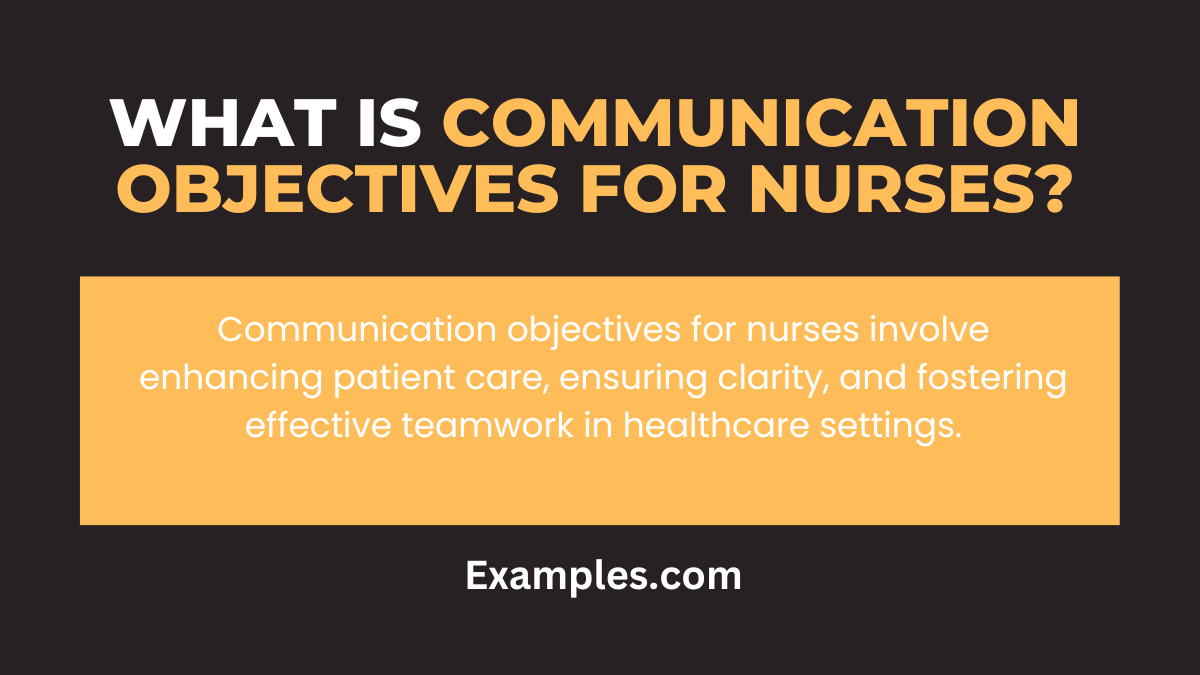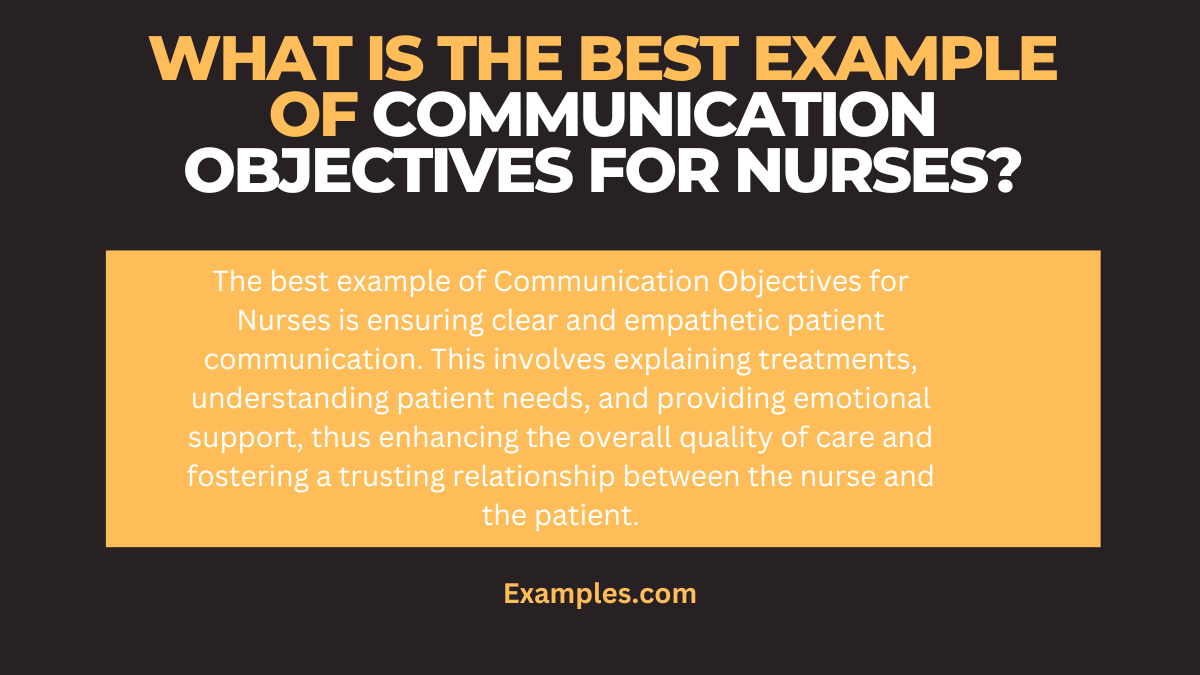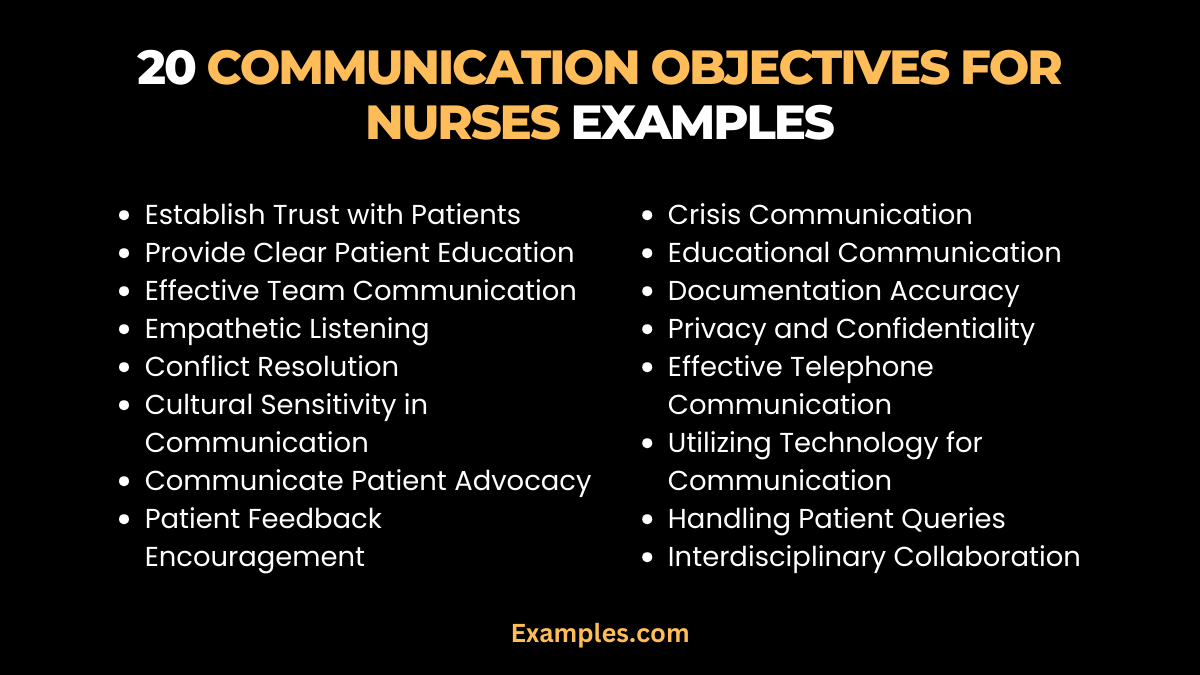19+ Communication Objectives for Nurses Examples
In the world of healthcare, effective communication is a cornerstone of quality nursing. This guide offers a comprehensive look at Communication Objectives for Nurses, providing valuable examples and actionable tips. Discover how mastering various communication skills, from empathetic listening to clear patient instruction, can enhance patient care and improve healthcare outcomes. This resource is tailored for both aspiring and experienced nurses, featuring communication examples that are relevant and practical in everyday nursing scenarios.
What is Communication Objectives for Nurses?

Communication Objectives for Nurses refer to the specific goals set by nursing professionals to enhance their interaction with patients, colleagues, and other healthcare stakeholders. These objectives aim to improve the quality of care through effective information exchange, emotional support, and patient education. Essential in a healthcare setting, these objectives focus on developing skills in verbal, nonverbal, and written communication, ensuring clarity, empathy, and professionalism in all interactions within the nursing field.
What is the best Example of Communication Objectives for Nurses?

One of the best examples of Communication Objectives for Nurses is establishing clear and empathetic communication with patients. This objective focuses on ensuring that nurses effectively convey medical information, listen to patient concerns, and offer emotional support. For instance, a nurse might use simple, understandable language to explain a treatment plan, ensuring the patient fully comprehends their care process. An essential part of this objective also involves active listening, where the nurse attentively listens to and addresses the patient’s questions or fears. This kind of communication is vital not only for providing high-quality care but also for building trust and rapport with patients, which can significantly impact their recovery and overall experience in the healthcare setting.
20 Communication Objectives for Nurses Examples

Nurses play a pivotal role in healthcare, where clear and compassionate communication is key. Understanding and effectively implementing communication objectives can significantly enhance patient care and healthcare outcomes. From building trust with patients to collaborating with healthcare teams, these objectives cover various aspects of nursing communication. Here are 20 unique and distinct examples, each with a brief explanation and example sentences for practical communication.
- Establish Trust with Patients: Create a comfortable environment for patients to share concerns.
Example: “I’m here to listen. Feel free to share anything that’s on your mind.” - Provide Clear Patient Education: Explain medical procedures and care plans in an understandable manner.
Example: “Let me walk you through your treatment plan so you know exactly what to expect.” - Effective Team Communication: Ensure information is accurately shared among healthcare professionals.
Example: “I’ve updated the team on the patient’s latest vitals and treatment responses.” - Empathetic Listening: Show genuine concern and understanding for patient feelings.
Example: “I understand this can be overwhelming. We’re here to support you every step of the way.” - Conflict Resolution: Address and resolve misunderstandings or disagreements effectively. Example: “Let’s work together to find the best solution for your concern.”
- Cultural Sensitivity in Communication: Respect and adapt to diverse cultural backgrounds of patients.
Example: “I appreciate you sharing your cultural practices with me, and I will make sure to consider them in your care plan.” - Communicate Patient Advocacy: Act as an intermediary between patients and other healthcare providers.
Example: “I will ensure your preferences are communicated to the doctor for the next steps in your treatment.” - Use of Nonverbal Cues: Utilize body language and facial expressions to convey empathy and understanding.
Example: “A nod and a comforting smile can often reassure a patient even without words.” - Feedback Reception and Response: Actively seek and respond constructively to feedback from patients and colleagues.
Example: “Thank you for your feedback. I’ll strive to incorporate your suggestions into my practice.” - Regular Health Status Updates: Keep patients and families informed about health progress or changes.
Example: “I’ll update you on any changes in your condition or treatment as soon as they happen.” - Crisis Communication: Effectively communicate during emergencies or critical situations. Example: “We need to act swiftly. Here’s what we’re going to do…”
- Educational Communication: Provide ongoing education about health conditions and self-care.
Example: “Let me explain how you can manage your condition effectively at home.” - Documentation Accuracy: Ensure all patient communications are accurately documented. Example: “I’m documenting our conversation in your file for consistent care.”
- Privacy and Confidentiality: Maintain patient confidentiality in all communications.
Example: “Rest assured, our conversations are confidential and your privacy is respected.” - Effective Telephone Communication: Convey clear and concise information during phone calls.
Example: “I’m calling to update you on your test results and discuss the next steps.” - Utilizing Technology for Communication: Leverage digital tools for patient education and updates.
Example: “You can access your treatment plan and educational materials through our online portal.” - Handling Patient Queries: Respond to patient questions with clarity and patience.
Example: “That’s a great question. Let me explain that for you.” - Compassionate End-of-Life Communication: Provide sensitive and supportive communication during end-of-life care.
Example: “We’re here to support you and your family during this time in any way we can.” - Interdisciplinary Collaboration: Communicate effectively with various healthcare disciplines for comprehensive care.
Example: “I’ll coordinate with the therapy team to align on your rehabilitation plan.” - Patient Feedback Encouragement: Encourage patients to provide feedback on their care. Example: “Your feedback is invaluable to us. Please let us know how we can improve your experience
Communication Objectives for Nurses Appraisal:
Effective communication is integral to nursing appraisals, where nurses assess and discuss their professional performance. Setting clear communication objectives for these appraisals ensures constructive and meaningful discussions, fostering professional growth and development. These objectives focus on openness, clarity, and receptivity to feedback.
- Articulate Self-Assessment: Clearly express your own performance evaluations.
Example: “I believe my patient care has improved significantly due to the advanced training I completed.“ - Discuss Professional Goals: Share your aspirations and future plans.
Example: “My goal is to specialize in pediatric care, enhancing my skills in this area.“ - Seek Constructive Feedback: Encourage open and honest feedback from superiors.Example: “I would appreciate your insights on areas where I can improve.“
- Express Training Needs: Communicate any additional training or support needed.
Example: “To further my skills, I would benefit from attending a course on advanced cardiac care.“ - Highlight Achievements: Discuss accomplishments and contributions.
Example: “This year, I successfully led the team during several emergency situations.“
Communication Objectives for Nurses Writing Basic Patient Notes
Writing patient notes is a critical task in nursing, requiring clear and accurate communication. Communication objectives for this task ensure that patient notes are concise, informative, and helpful for ongoing patient care.
- Clarity in Documentation: Write notes that are clear and easy to understand.
Example: “Patient exhibited increased mobility post-medication adjustment.“ - Accuracy of Information: Ensure all details are precise and correct.Example: “Administered 5mg of Medication X at 10 AM; no adverse reactions noted.“
- Timeliness in Note-Taking: Document patient interactions as soon as possible.
Example: “Immediately recorded observations post-consultation for accurate recall.“ - Relevance of Content: Include only pertinent information in notes.
Example: “Noted patient’s specific symptoms relevant to their ongoing treatment plan.“ - Use of Standard Medical Terminology: Employ universally understood medical language. Example: “Patient diagnosed with acute otitis media; prescribed appropriate antibiotic therapy.“
What are the Objective Goals of Effective Communication in Nursing?
Effective communication in nursing is pivotal for delivering high-quality patient care and ensuring smooth operations within healthcare teams. The objective goals of effective communication in nursing include:
- Enhancing Patient Care: Clear communication ensures patients understand their diagnoses, treatment plans, and self-care instructions, leading to better health outcomes.
- Building Trust with Patients: Open and empathetic communication fosters trust, making patients more likely to share crucial health information.
- Improving Team Collaboration: Effective communication among healthcare professionals enhances teamwork, leading to more coordinated and efficient patient care.
- Ensuring Patient Safety: Accurate and timely information exchange can prevent medical errors and enhance patient safety.
- Facilitating Continuity of Care: Consistent communication ensures that patient care is seamless across shifts and different caregivers.
- Managing Healthcare Settings: Clear communication is essential for the smooth operation of healthcare facilities, including handling emergencies and routine care.
- Supporting Professional Development: Feedback and discussions among colleagues promote learning and professional growth.
- Promoting Public Health Education: Nurses often communicate health education to patients and communities, playing a vital role in public health promotion.
In conclusion, this guide on Communication Objectives for Nurses offers a thorough overview of the essential communication skills and strategies needed in nursing. From enhancing patient care to fostering effective team collaboration, the examples and insights provided aim to equip nurses with the tools for successful communication in various healthcare settings, ultimately leading to improved patient outcomes and professional satisfaction.


